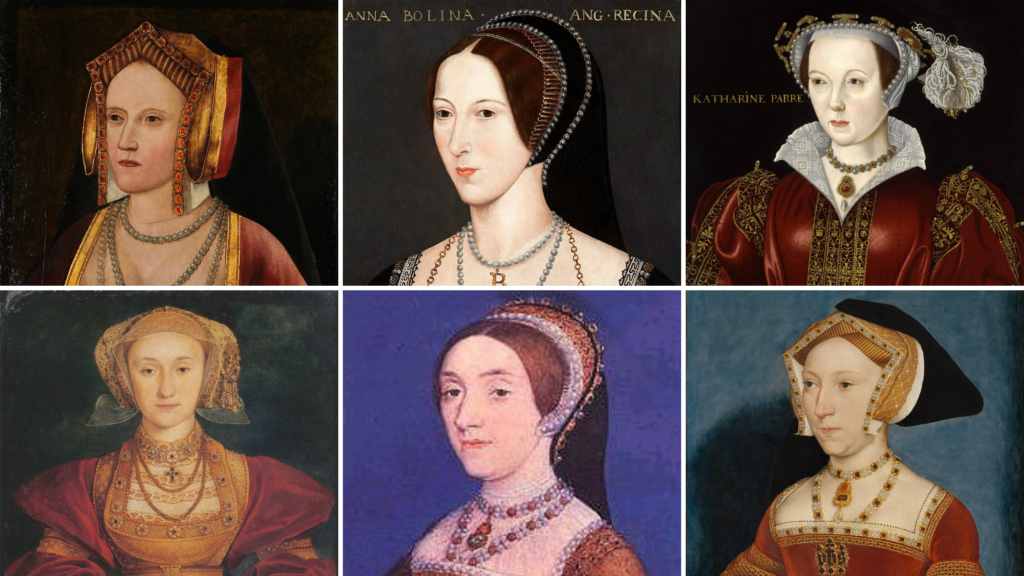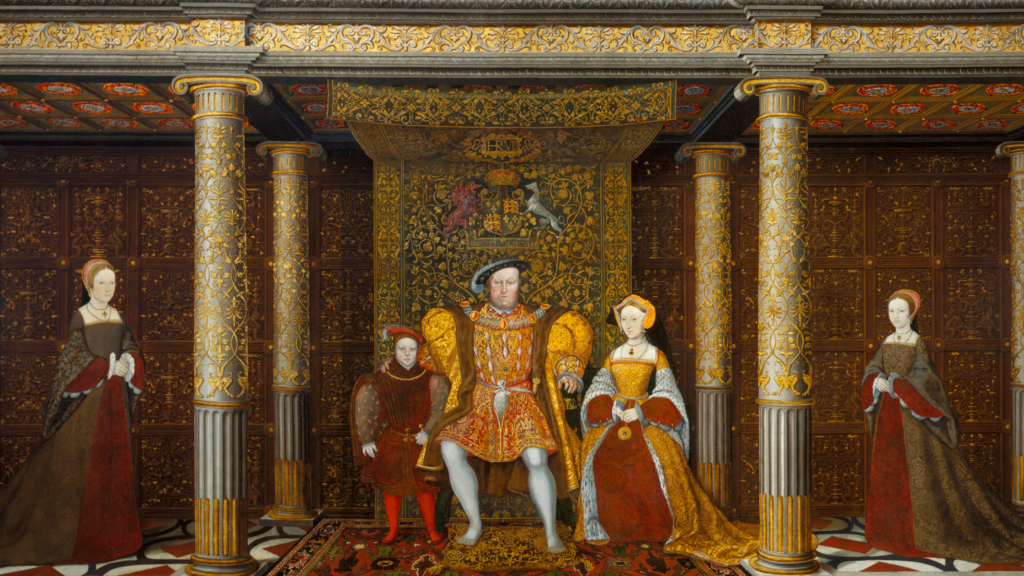Who were the six wives of Henry VIII? He became one of Britain’s most famous monarchs. Egotistical, paranoid and desperate for a male heir, he broke with the Catholic church, made himself the head of the English Church, killed his friends who wouldn’t support him or couldn’t give him what he wanted and married six times.

Catherine of Aragon – Divorced
The first woman Henry married was his brother’s widow.
Catherine of Aragon was 3 years old when she was betrothed to Arthur, the oldest son of Henry VII in a political alliance. They married at 15 and 3 months later, he was dead.
Instead of returning to Spain, Catherine stayed in Britain as the world’s first female ambassador. King Henry wanted Catherine to marry his younger son to keep the alliance. He asked the Pope for a dispensation for the marriage, the Pope was willing, but Henry refused.
When his father died and Henry became king, he suddenly changed his mind and married Catherine. He was 18 and she was 23.
Catherine was a great queen and a supportive wife, but was unable to give Henry the son he wanted. She suffered numerous miscarriages and only had one child who survived more than a few weeks.
By the time Henry met the young Anne Boleyn, Catherine was too old to have more children. The ambitious Anne refused to become his lover while he was married, and Henry became obsessed with getting an annulment.
The Pope, who was being held prisoner in Rome by Catherine’s nephew, Holy Roman Emperor Charles V, refused to help. When his ministers couldn’t come up with a solution, Henry solved the problem by making himself the head of the church in England. He divorced his wife of 24 years and banished her from court. Henry refused to allow Catherine to see her daughter, unless she recognized Anne as the queen. She refused.
Catherine died of cancer in Cambridgeshire in 1536 when she was 51.
Anne Boleyn – Beheaded
Henry’s second wife wasn’t a popular queen.
Well-educated in France where her father had been a diplomat, Anne came to court as a lady-in-waiting to Catherine of Aragon. Her sister had been the King’s mistress, Anne didn’t want the same thing to happen to her and refused to begin an affair.
When the Pope refused another annulment, Anne encouraged Henry to explore the new religion that was sweeping Western Europe. The Protestant Reformation opposed the Pope and the corruption of the Catholic Church. Eventually Henry rejected the Pope’s authority and declared himself the head of the church in England so he could marry the woman he hoped would give him an heir.
Like Catherine, Anne suffered several miscarriages and her only surviving child was a girl. But unlike Catherine, Anne wasn’t a dutiful wife. She was ambitious and extravagant, trying to use her power to influence the King and court.
After 3 years of marriage, Henry instructed his Chief Minister, Thomas Cromwell, to find a way to get rid of his second wife. Cromwell accused Anne of treason, incest and adultery and she was beheaded on 19 May 1536 at the Tower of London.
A week after Anne’s death, Henry married Jane Seymour.
Jane Seymour – Died
Seymour had been a lady-in-waiting to both previous queens when she caught Henry’s eye.
Henry was still looking for a male heir; Jane was quiet, gentle and young. 10 days after Anne’s death, Jane became wife number 3.
Jane was a popular queen. Like Catherine of Aragon, she was Catholic and had been sympathetic to the first queen and her daughter. She became close to her stepdaughter Mary and helped restore the relationship between her and the king.
Jane was the mother to Henry’s only legitimate son, the future Edward VI. The king was delighted at the birth of a healthy son, but the birth was difficult, and Jane died at Hampton Court Palace a few weeks later. She was the only one of Henry VIII’s wives to receive a queen’s funeral. Over time he became more attached to her, she continued to appear in official portraits and at Henry’s request, he was buried next to Jane at Windsor Castle.
Henry’s advisors started looking for his next wife.

Anne of Cleves – Divorced
Thomas Cromwell urged Henry VIII to form an alliance with the protestants of Western Germany by marrying one of the sisters of the leader, William of Jülich-Cleves-Berge.
The king wasn’t against the idea and sent the King’s Painter, Hans Holbein the Younger, to paint portraits of the girls, instructing him to be realistic.
Anne arrived in England in 1540 ready to marry, but the 49-year-old Henry declared he wasn’t attracted to her. He asked Cromwell to find a way to avoid the marriage, but there was no way out of it without offending Anne’s brother.
The wedding went ahead, but Henry couldn’t bring himself to consummate the marriage. After 6 months, Anne agreed to an annulment and Henry had his closest advisor tried for Treason. Anne received a generous settlement and she and Henry became great friends until his death.
Catherine Howard – Beheaded
Next up was the youthful Catherine Howard, cousin of wife number 2, Anne Boleyn.
Catherine was still a teenager when she married the middle-aged monarch less than 3 weeks after his divorce from Anne of Cleves.
She wasn’t particularly well-educated, but Catherine was fun-loving and vivacious, capturing the king’s attention. He showered her with gifts and raised the status of the Catholic Howard family. They married on the day that Cromwell was executed, with Catherine’s uncle, the Duke of Norfolk, keen to take his place as Chief Minister.
There were rumors that Catherine had had a sexual relationship with Francis Dereham before she married the King, and Thomas Culpeper during her marriage. Letters from the queen were found in his chamber, all three were arrested and the men were quickly executed for high treason. Catherine followed them a few months later.
Catherine Parr – Survived
The next year, Henry married for the last time. By this time he was severely obese and in constant pain from leg ulcers.
Catherine Parr was in her early 30s and twice widowed when she met Henry. She was going to marry Sir Thomas Seymour, brother of the third wife of Henry VIII, but she believed it was her duty to accept the king’s proposal and help ensure England remained Protestant.
Catherine was a kind and caring queen. She was close to the king’s children and convinced Henry to restore his daughters to the order of succession. Although prominent Catholics at court tried to discredit her, she was able to convince the king that she was loyal to him until the end of his life.
When the king died, Catherine secretly married Thomas Seymour. She became pregnant for the first time when she was 35 and died shortly after her daughter was born.
Jane Seymour’s son, Edward VI became king when he was 9 years old. After 6 years, he died suddenly from illness and his half-sister, Mary, became queen. She tried to restore Catholicism in England but was generally unpopular. Five years later, Anne Boleyn’s daughter, Elizabeth became queen and brought England back to Protestantism. She was the last and the greatest of the Tudor monarchs; historians consider her 44-year-reign the Golden Age of English history.
